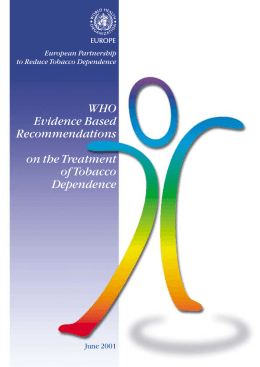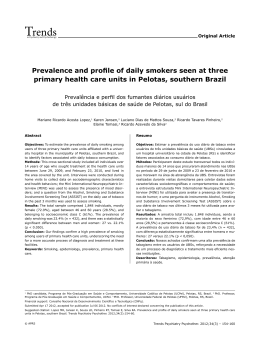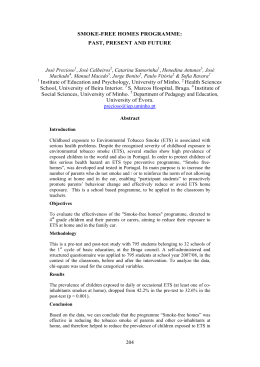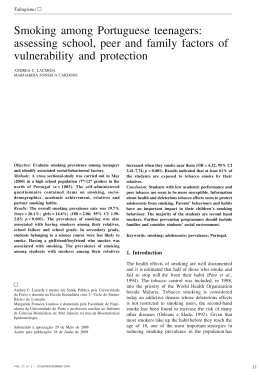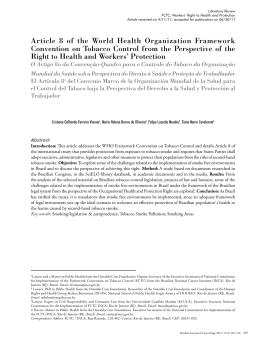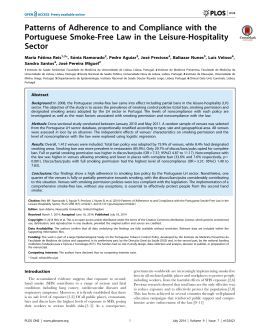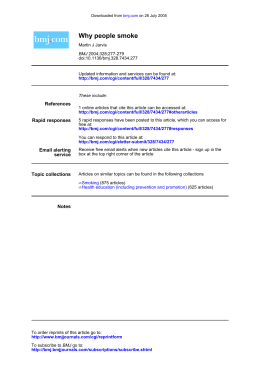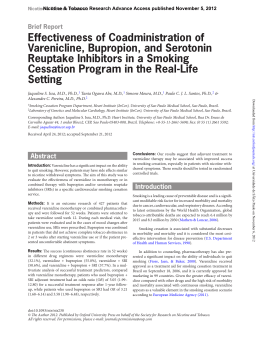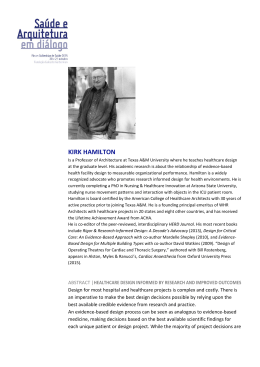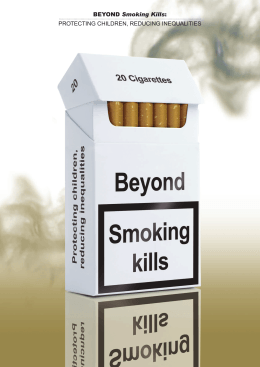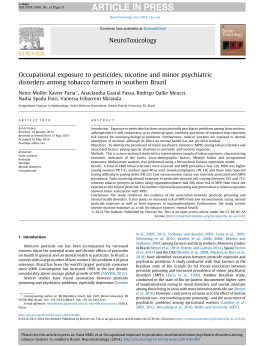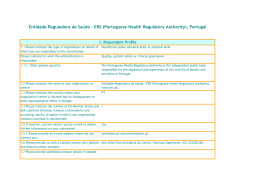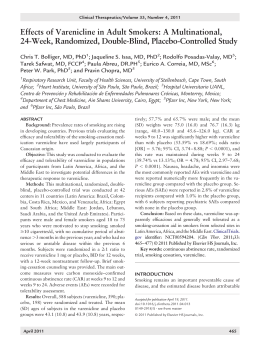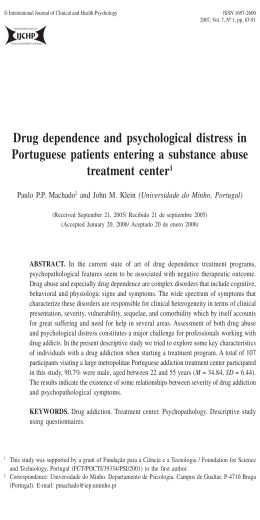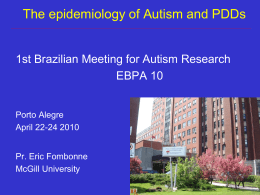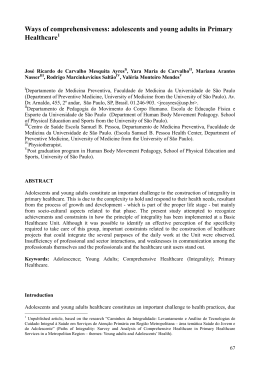The Europe Quitting: Progress & Pathways (EQUIPP) Report 01.0 Fact: In the World Health Organization (WHO) European Region, the overall adult daily estimated smoking prevalence (population-weighted) has stabilised at around 28%.1 02.0 Fact: There is a clear distinction between gender, with an estimated average smoking prevalence of 40% among males and 18% among females.1 03.0 Fact: The WHO estimates the annual global cost of tobacco is US $500 billion.2 01.0 introduction Tobacco use is the single largest cause of death and disease in the European Union (EU)3 killing half of all lifetime users, with half of these dying between 35 and 69 years old.4 In an effort to combat tobacco use and drive down these figures, EU member states have signed up to the world’s first international public health treaty: The Framework Convention on Tobacco Control (FCTC).5 Article 14 of the FCTC demands What can be done to combat these avoidable deaths in Europe? The EQUIPP report is a comprehensive, major study based on extensive research, expert opinion and insight, assessing the current state of smoking cessation infrastructure in 20 European countries. Each country has been evaluated against 17 different criteria across the key areas of policy, education and services, which would together contribute to the “ideal” infrastructure for helping smokers quit. The EQUIPP report has been developed to provide policy makers and healthcare professionals (HCPs) with actionable recommendations to improve smoking cessation infrastructure and tobacco control measures and to ensure support is provided to all smokers who want to quit. action to promote cessation of tobacco use and provide adequate treatment for tobacco dependence.5 The EQUIPP report helps those responsible for implementing Article 14 to deliver against their obligations by providing them with a national situation analysis.5 Recommendations in the EQUIPP report have been compiled based on input from over 60 leading tobacco dependence, smoking cessation and tobacco control experts. The report follows interviews and a comprehensive review of data and best practice across Austria, Belgium, Czech Republic, Denmark, Finland, France, Germany, Greece, Hungary, Ireland, Italy, Luxembourg, the Netherlands, Norway, Poland, Portugal, Spain, Sweden, Switzerland and the United Kingdom. Not only is tobacco dependence one of Europe’s biggest health problems, but it places considerable, avoidable strain on the economy as well. 02.0 EQUIPP report key recommendations The EQUIPP Report’s Editorial Partners recommend the following actions are taken across Europe (presented in the order of the themes in the report and not in any ranked order or preference): Tobacco Pricing 1.Increase tobacco prices Anticipated outcomes from this recommendation: • Decreased consumption of tobacco products • Decreased smoking prevalence • Possible decrease in young people taking up smoking Example of best practice: • Denmark: The government increased cigarette tax by Danish Krone 3.006 (or by approximately 10%) in January 2010. The Danish Heart Association has calculated that a tax increase of 10% should lead to a 4% reduction in consumption7 Reimbursement 2.Reimburse time for providing smoking cessation counselling (or increase existing reimbursement) Anticipated outcomes from this recommendation: • Increased access to smoking cessation services (particularly for those from lower socio-economic groups) • Increased uptake of smoking cessation services • Increased numbers making a quit attempt • Increased number of successful quitters Example of best practice: • Ireland: Smoking cessation services provided by the Health Service Executive (HSE) are free for all who are directed to that service 3.Reimburse smoking cessation medications Anticipated outcomes from this recommendation: • Increased numbers making a quit attempt • Increased number of successful quitters Example of best practice: • UK: The only country to provide full reimbursement of smoking cessation medications Guidelines 4.Provide national guidance and clinical guidelines (or implement existing ones) Anticipated outcomes from this recommendation: National guidance • Increased provision of appropriate services • Evidence-based standardisation of services Example of best practice: • UK: Each of the nations has its own smoking prevalence targets and there is national guidance to achieve these targets, for instance, the public health guidance on workplace health promotion provided by the UK’s National Institute for Health and Clinical Excellence (NICE).8 National clinical guidelines • Recognition that tobacco dependence is a disease • Increased ability of healthcare providers to deliver evidencebased services • National consistency of treatment • Provision of tools for monitoring and surveying progress • Protection from unproven, ineffective and expensive treatments • Cost-effective resource utilisation Training and Education 5.Further training for primary care physicians Anticipated outcomes from this recommendation: • GPs will establish their patients’ smoking habits and treat smoking as a disease • GPs will promote and support smoking cessation programmes and follow-up patients as needed 6.Involve primary care physicians more in smoking cessation programmes Anticipated outcomes from this recommendation: • Helps to establish tobacco dependence as a disease • Likely to increase the volume of research into the disease • Provides evidence-based standardisation of services • Increased provision of validated smoking cessation services • Greater use of known successful interventions 7.Improve training for all healthcare professionals Anticipated outcomes from this recommendation: • Helps to establish tobacco dependence as a disease • Likely to increase the volume of research into the disease • Provides evidence-based standardisation of services • Increased provision of validated smoking cessation services • Increased reach of smoking cessation services to a wider population • Facilitate team building and network formation between healthcare professionals Examples of best practice: • Norway: In Norway, treatment of tobacco dependence is part of the national health programme and the primary healthcare programme9 • UK: The national training programme for nurses, GPs and stop smoking advisers that was developed by the NHS Centre for Smoking Cessation and Training (NCSCT) is currently being rolled out in the UK10 and may be considered best practice for developing training programmes for HCPs in other countries In addition to these recommendations which are considered key and applicable across many countries, the EQUIPP report interviewees also provide recommendations relevant to each country studied. These country-specific recommendations include tightening the existing smoke-free legislation, providing healthcare professionals with guidelines in their local language, and improving the education for the general public so that they can better understand smoking as a disease and the resources available to help them quit (e.g. quitlines). 03.0 An ideal country The Editorial Partners combined the report recommendations with their own experience to establish an “ideal country”; providing an outline of the steps and standards that it is recommended are established to facilitate significant progress in reducing tobacco control in each European country studied. This will help to pave the way for real public health gains and reducing related strains on the economy. The “ideal country” includes: Policy features compared to an ideal country • Widespread understanding and official recognition that tobacco dependence is a disease • Surveillance of smoking prevalence and monitoring success of smoking cessation services • Smoking prevalence targets set and tracked • Tobacco prices set at a high-level • Reimbursement of time for providing smoking cessation services and reimbursement of treatment • Full access to smoking cessation services • Full implementation and enforcement of smoke-free legislation • No tobacco industry advertising or promotional activities Service features compared to an ideal country • Physicians comprehensively involved in smoking cessation • All healthcare professionals comprehensively involved in smoking cessation • Smoking cessation services organised from a central organisation with a network of smoking cessation centres • Smoking cessation strategy with guidance on service provision available and with government endorsement • Medical society approved treatment guidelines disseminated and implemented Education features compared to an ideal country • Physicians educated and trained on smoking cessation • All healthcare professionals educated and trained on smoking cessation • The general public (particularly children and people in lowersocio economic groups) educated on smoking and smoking cessation • Medical students educated on smoking and smoking cessation 04.0 The authors and interviewees The EQUIPP report was developed in conjunction with four Editorial Partners, who are leading experts in tobacco dependence, smoking cessation and tobacco control in Europe: • Dr. med. Thomas Hering, MD – Physician for pneumology, allergies and sleep medicine and Vice-Chairman of the German Association of Pulmonologists, Germany • Antonella Cardone, MS, MBA – Expert in Tobacco Control and Public Health and Director, Global Smokefree Partnership, Italy • Prof. Witold Zatoński, MD, PhD – Director, Department of Cancer Epidemiology & Prevention, Maria Sklodowska-Curie Memorial Cancer Center & Institute of Oncology, Poland • Prof. Luke Clancy, BSc, MB, MD, PhD, FRCPI, FRCP (Edin), FFOMRCPI – Director General, TobaccoFree Research Institute in Ireland To provide a national perspective, interviews and meetings were also conducted with over 60 independent tobacco dependence, smoking cessation and tobacco control experts across each of the 20 countries studied. 05.0 References WHO Europe. The European Tobacco Control Report 2007 2 WHO. Tobacco Atlas 2006 Available at: http://www.tobaccoatlas.org/downloads/maps/Chap11_EconomicCosts.pdf. Accessed July 2010. 3 Mladovsky P, Allin S, Masseria C, et al. Health in the European Union, Trends and Analysis (2009). European Observatory on Health Systems and Policies. World Health Organization 4 WHO. Tobacco Atlas. 2002 5 WHO Framework Convention on Tobacco Control, World Health organisation, Geneva, Switzerland, 2005. ISBN 92 4 159101 3 6 KPMG. Global Indirect Tax Brief. 2009 7 Danish Heart Association (Hjerteforeningen). Baggrund for Hjerteforeningens forebyggelsespolitik 2009. [In Danish] December 2008 8 NICE. Public Health Intervention Guidance 5. Workplace health promotion: how to help employees to stop smoking. 2007 9 WHO Tobacco database. Available at: http://data.euro.who.int/tobacco/Default.aspx?TabID=2404. Accessed December 2010. 10 NHS Centre for Smoking Cessation and Training. Website. NCSCT Frequently Asked Questions. http://www.ncsct.co.uk/frequently_asked_questions.html Accessed December 2010. 1 Pfizer initiated the EQUIPP report and provided the funding. For further media information please contact: [email protected] Date of preparation: February 2011 Job number: EUSC1170
Download
